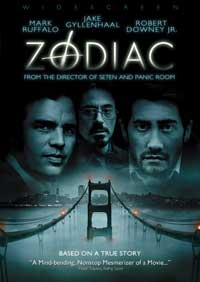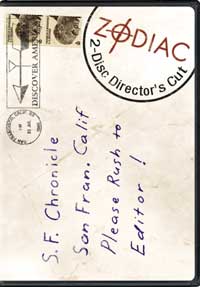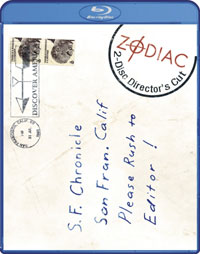


DVDSleuth.com is your source for daily DVD news and reviews.



Zodiac (2007)
Paramount Home Entertainment
DVD Released: 7/24/2007
All Ratings out of ![]()
![]()
![]()
![]()
![]()
Movie: ![]()
![]()
![]()
Video: ![]()
![]() 1/2
1/2
Audio: ![]()
![]()
![]()
![]()
Extras: None
Review by Mike Long, Posted on 7/9/2007 -- Updated on 1/11/2008
When describing a movie, the words "docudrama" or "Based on Actual Events" or "Based on a True Story" should be completely innocuous. However, for many film-fans (especially those of us who grew up in the 1970s), these words have been hijacked and cheapened thanks to the countless TV movies which carried this moniker. (I've always assumed that this was cheaper than hiring someone to write an original story.) (One particular network has been a major culprit in this. I'm not going to name names, but it rhymes with "Riferime.") But, this perception has never stopped Hollywood from turning to real-life to find inspiration for their films. These movies are often big-budget affairs complete with well-known stars, as the fillmmakers attempt to rise to the significance of the true story. A recent example of this is David Fincher's Zodiac.
Zodiac opens on July 4, 1969 in Vallejo, California. A young couple are shot by a stranger while parking. The woman is killed and the man is wounded. Nearly three months later, another young couple is attacked near Napa, California. Again, the woman is killed and the man survives. A letter is sent to the San Francisco Chronicle and the writer claims to be the killer. He identifies himself as "Zodiac" and demands that the paper print his letter. Crime-beat writer Paul Avery (Robert Downey, Jr.) is immediately drawn to the story, as is political cartoonist Robert Graysmith (Jake Gyllenhaal). A few weeks later, a cab driver is murdered, and again "Zodiac" sends a letter to the paper claiming responsibility. Police detectives David Toschi (Mark Ruffalo) and William Armstrong (Anthony Edwards) are assigned to the case. From here on out, Zodiac follows the lives of Graysmith, Avery, and Toschi, as the men struggle to learn the identity of the killer. While Toschi follows numerous leads and works with the Vallejo and Napa police departments, Avery writes scathing columns about the killer, which earns him personal threats from "Zodiac". But, it's Graysmith, the humble cartoonist, who becomes obsessed with the case, chasing down every possible lead. Can this man find something which the police overlooked?
Zodiac is a period pieced in the sense that it's set in the 1970s and the characters, costumes, locations, cars, etc. look as if they came from the 70s. However, Fincher has taken things one step further and created a movie that looks as if it were made in the 70s. Even if this were wild conjecture, the fact that the film opens with 1970s-era Paramount and Warner Brothers logos certainly backs my hypothesis. Fincher has dropped his trademark dark look for the most part, and given the film a style more similar to The French Connection or All the President's Men. Another throwback to the 70s is the fact that this is a BIG film. The movie clocks in at 157 minutes and it not only has stars in the lead roles, but there are very familiar faces peppered throughout the film in medium to very small roles.
And in that sense of bigness, screenwriter James Vanderbilt, working from Graysmith's book, has included many of the well-known and minute details of the case, starting with that 1969 murder and going all the way to 1991. The film not only deftly explores the details of the case, but the lives of Graysmith, Avery, and Toschi as well. In an unusual conceit, the film, which gives specific dates for each scene, will show several days of the investigation, or will sometimes linger on a just a few moments of one day in the timeline.
And yet, for all of this detail, all of this realism, Zodiac feels very hollow and cold. Fincher's film, most notably Fight Club and Se7en, often have a very gritty feeling of reality, no matter how fantastic the situation. Here, we have a real-life story which come across as very distant and unknowable at times. It's clear that the movie is in the hands of a skilled filmmaker (see the scene where Toschi interviews his key suspect), but some parts of the movie are mechanical and pedestrian. And this may not be true for every viewer, but for me, Zodiac suffered from the "Titanic effect" -- that is, I knew how it was going to end, so there was little suspense in the story. And while many movie aficionados would most likely consider Fincher a better director than Ron Howard, Howard proved with Apollo 13 that a well-known true story could still be suspenseful when made into a movie. One place where Zodiac doesnít disappoint is in the acting, as the all-star cast is very good. Downey brings his apathetic confidence to the film playing a man just crazy enough to taunt a killer. Gyllenhaal and Ruffalo both play men who become irrevocably caught up in the crime, with Gyllenhaalís character slipping into obsession.
Zodiac is the first David Fincher film that Iíve found disappointing since Alien3. The movie is incredibly well-made and well-acted, but at the end of the day, it feels like a big-budget episode of Unsolved Mysteries. This isnít entirely the fault of the filmmakers, as Zodiac left little for the authorities to go on and the movie is made up of the parts which Graysmith and others tried to fill in. Those both familiar and unfamiliar with the case will learn something from this detailed film, but donít expect to be blown away.
Zodiac mails a cryptic letter to DVD courtesy of Paramount Home Entertainment. The film has been letterboxed at 2.35:1 and the transfer is enhanced for 16 x 9 TVs. This DVD represents the worst looking major-motion picture DVD that Iíve seen in years. Using a LCD monitor and a upconverting DVD player, Zodiac delivered an incredibly bad picture. The image is littered with aftifacting and video noise. Every character (and many inanimate objects) looked as if they were wearing that cloaking suit from Predator, as they shimmered constantly. This was very distracting was noticeable in every scene. Funny, outside of that the image is OK, as thereís no grain and the colors look good, but that shimmering and the wavy lines were too constant to be ignored. The DVD carries a Dolby Digital 5.1 audio track which delivers clear dialogue, music, and sound effects. The stereo effects are well done, and the track brings in some well-placed surround sound and subwoofer effects. However, unlike Fincherís other films, the movie doesnít feature a constant barrage of LFE tones.
The Zodiac DVD contains no special features...save for a commercial for the directorís cut special edition of the DVD, which will premiere in 2008. Youíve been warned.
ADDENDUM: On January 8, 2008, Paramount Home Entertainment released the previously advertised 2-disc Special Edition of Zodiac. This edition contains the Director's Cut of the movie, which runs some 4 minutes longer than the theatrical cut. This edition didn't change my opinion of the movie. I still think that it's very well made, but dull.
That aside, this DVD is, without a doubt, an improvement over the first
release. Disc 1 contains the film. The transfer looks much better than the
previous disc. Again the image is letterboxed at 2.35:1 and the transfer is
enhanced for 16 x 9 TVs. The image is sharp and clear -- very clear -- showing
none of the issues from the earlier DVD. The image shows no grain or defects
from the source material. Even patterns such as plaid shirts don't show the
video noise which plagued the first release. The picture has a nice depth and
the colors look good. Simply go to the exterior scene in Chapter 4 to see the
vast improvement in this disc. The Dolby Digital 5.1 audio track sounds the same
as the first release.
Disc 1 contains two extra features, both AUDIO COMMENTARIES. The first
commentary is by David Fincher. This is a very good talk, as Fincher speaks at
length throughout the film. Fincher has a reputation for being intimidating and
difficult, but he comes off as humble and thoughtful on this commentary, even
going as far as to apologize to his actors for having to re-shoot a scene. He
talks about his childhood in the San Francisco area and what the story means to
him. He then talks about the mechanics of making the movie. The second
commentary has Jake Gyllenhaal, Robert Downey, Jr., Producer Brad Fischer,
writer James Vanderbilt and L.A. Confidential author James Ellroy. This
is a good commentary as well, as though it should be noted that the actors are
recorded separate from the others, and they aren't featured as much as Fischer,
Vanderbilt, and Ellroy. (Although Gyllenhaal and Downey have some funny
comments.) We learn even more about the making of the film here and Ellroy has
some good thoughts on the realistic nature of the film and how it accurately
portrays an investigation.
Disc 2 is split into two sections, "The Film" and "The Facts". "The Film"
opens with "Zodiac Deciphered" (54 minutes) which is a comprehensive examination
of the film's production. Screenwriter James Vanderbilt describes his
introduction to the material and how he and producer Brad Fischer got the rights
to the film and how Fincher became involved. We then get a detailed look at the
shooting of the movie with a view of the sets and locations and on-set footage
of the action. Costumes, props, and historical accuracy are discussed. While
there are comments from many involved, we don't get to hear from Fincher. There
are some shots here which are labeled as "Deleted Scenes", but there are no
official deleted scenes on the DVD. "The Visual Effects of Zodiac" (15
minutes) shows how the effects were used in the film. Through clips, comments
from the effects artists, and detailed breakdowns of certain shots, we see how
the nearly invisible visual effects really enhanced the film, most notably the
murder scenes and those shots which depict San Francisco in the past. "Previsualiization"
gives a side-by-side comparison between the finished film and the animatic which
is used to illustrate what the film will look like and which shots will be used.
We also get the Theatrical Trailer which is letterboxed at 2.35:1 and is16 x 9.
"The Facts" has two segments. "This is Zodiac Speaking" (102 minutes) is an
incredibly detailed look at the Zodiac case starting at the very beginning. The
piece uses archive photos and footage combined with modern day interviews with
the investigators and survivors who recount their experiences. While it is
exhaustive, this is also exhausting, as the pace is quite slow. And there are
odd moments where the screen goes black for a few seconds. "Prime Suspect: The
Name was Arthur Leigh Allen" (43 minutes) appears to have been made by the same
people who did "This is Zodiac Speaking" as the look and style are very similar.
This takes an in-depth look at the life and behavior of Allen, who many believe
(as relayed in the movie) was in fact The Zodiac. Those who knew Allen are
interviewed as are law enforcement officials.
UPDATE: On January 20, 2009, Paramount Home Entertainment released Zodiac on Blu-ray Disc. The film has been letterboxed at 2.35:1 and the Disc contains an AVC 1080p HD transfer which runs at an average of 32 Mbps. The image is incredibly sharp and clear, showing no grain and no defects from the source material. Fincher's natural approach to the look of the film works very well here. The colors look good and the image is never too dark or bright. The picture shows good depth, especially in exterior scenes, and the foreground is nicely separated from the background. The image also has a nice amount of detail, which is only aided by the crispness of the picture. The Disc contains a Dolby TrueHD 5.1 audio track which runs at 48 kHz and an average of 3.0 Mbps. The track provide clear dialogue and sound effects. This is an impressive track as the stereo effects are highly detailed and show nice stereo separation. The surround sound effects are a bit more subtle, but when used, they are quite impressive and help to create a sense of space while watching the movie. The street scenes really show nice use of the stereo and surround effects. The subwoofer effects are sparse here, but they do help to punctuate gunshots.
The Zodiac Blu-ray Disc contains the same extras as the two-disc DVD.
Review Copyright 2007-2008-2009 by Mike Long